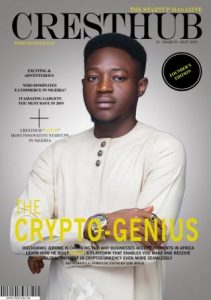Non-Fungible Tokens (NFTs), Decentralized Finance (DeFi), Blockchain, Cryptocurrency and now Web3. These are some of the words that have been buzzing on the internet for some time now. We hear people talk about Web3 and many have described it as the future of the internet. But, what is Web3 anyway? And why is everybody talking about it?
Before we dive into Web3, here’s a brief introduction as to how it all began.
The internet as we know it was birthed and launched by Tim Berner-Lee in December, 1990 with the aim of creating a decentralized means of information dissemination. But as far as history goes, there’s been two generations of the internet so far and still no decentralization. Herein lies the story of the world wide web:
Web 1.0: The Read-Only Era (1990-2004)
This era has largely been described as the age of “syntactic web”; when the internet was built and controlled by skilled web developers and programmers. This was the period when information was transmitted through static and personal websites using hyperlinks. Users could only read information online but could not contribute to the web or interact through/with it as we now can.
At the time, the internet worked like an archive of information where data was uploaded by the privileged few for other users to consume without interference or contribution. By the late 1990s, it had become more or less an advertising tool for those who could afford it.
In an interview with Wired in 1997, Tim had stated that he had not intended the web to act as a broadcast or advertising tool. However, he said “my gut feeling is that one should be able to negotiate how one’s information is used. The information world is a market. And in a market, it’s up to individual people – individual creativity – as to what sort of contracts they draw up. If you feel some marketer is going too far, you can quit. That’s what I mean by negotiation.”
Web 2.0: The Read-Write era (2004-date)
The transition from web 1.0 to 2.0 was a subtle one with the emergence of new technologies like HTML, Javascript and social media platforms like MySpace and Facebook which gave internet users the ability to influence the web. This is the age we currently live in. An age of interactivity and interconnectivity that has transformed internet consumers into prosumers (users and producers of contents) and the world into a global village.
The benefits of web 2.0 are enormous. Ranging from social media to e-commerce, e-payments e-government, the influx of startups and tech-driven innovations and so much more. This current age has been closely associated with ease and efficiency, free, fast and widely accessible transactions and interactions and the list goes on and on.
However, there have been many drawbacks associated with it as well. Disadvantages like cyber-bullying, cyber-theft and scams, false news, exposure to inappropriate content, etc. And although the system aims at decentralizing internet access, some big tech companies have been identified as the key players in this era. They include: Google, Apple, Meta and Amazon and Microsoft. They have been described as the five largest, most dominant companies in the information technology industry.
Although prosumers can create content and advertise their businesses on the web, they are not the major beneficiaries of the profits. These companies make the rules and regulate the data and activities of their users. Hence, the need for a better alternative.
Web 3.0: Read-Write-Own
The term “Web3” was coined in 2014 by Ethereum’s co-founder, Gavin Wood. It is an umbrella term used to describe a new attempt at decentralizing and democratizing the web by leveraging blockchain, cryptocurrency and NFTs.
Chris Nixon, a key player in the campaign to sensitize internet users on the Web3 era had explained that “Web3 has set out to break up the market power of these centralized players by replacing the centralized server-client infrastructure with distributed ledgers, the most common type being the blockchain. So instead of all data being stored on a centralized server, it will be scattered across a decentralized computer network. Centralized entities, which previously acted as intermediaries, will thus become obsolete.”
Understanding the concepts that make up Web3
- NFT: These are tokens/properties that when won or bought give owners certified ownership on them. We’ve seen platforms like Facebook and Instagram selling NFTs to consumers to ensure that their contents remain theirs. By using NFTs, what Web3 hopes to accomplish is a marketplace where creators’ rights of ownership are protected and where these contents are not controlled and owned by a centralized body but by people who have the rights to them.
- Cryptocurrency: Since the introduction of Bitcoin in 2009, the world has witnessed a steady transition into a cashless era. Now people can buy and sell these digital currencies known as crypto coins and secure wealth online. To the extent where entire countries (El Salvador and Central African Republic) have taken bold steps to adopting these digital currencies as their legal tenders.
- DeFi: Decentralized Finance (DeFi) is a platform that offers monetary contracts (cash and/or assets) to users using smart contracts on blockchain without the interference of banks or brokerages.
- DAOs: Defined by Ethereum as agreed-upon smart contracts that automate decentralized decision-making over a pool of resources (tokens)”, Decentralized Autonomous Organizations (DAOs) are basically Web3 communities that allow users with tokens to vote on how resources get spent, and the code automatically performs the voting outcome. They act as legal institutions that govern the way Web3 is utilized until the system is strong enough to stand ungoverned and decentralized to welcome all.
Benefits of Web3
- Democratization of ownership: A key feature/benefit of Web3 is its goal to decentralize the web. In a decentralized system, transactions between users of internet platforms will be easier and more to the users’ control. In this case, users can earn money online, save, invest and spend online without the need for third parties like traditional banks. Even the social media will be more democratized so that where once users were limited to viewing and creating contents, they can now lay claims to their contents and sell them as they please. No more restrictions or control.
- Ease of control: Another advantage of Web3 is that it unifies users’ accounts so that users can conveniently access and manage all their web accounts from a single web3 platform which serves as the master-key to locking and unlocking them all.
- More job opportunities.
Setbacks of Web3
While these advantages look promising, here are a few downsides to the plan:
- Limited access: about half of the world still lacks internet access; a major necessity for accessing these opportunities.
- Volatile: over the years, cryptocurrencies have considered a highly unstable risk as their prices are almost always changing. Hence the fear of losses.
- Illiteracy: the world is still battling with high computer illiteracy in developing countries who are still unable to use the web 2.0. So how do we introduce a new age when the old is yet to be generally understood?
The Development of Web3 in Africa
In a 2021 report by Chainalysis, the African cryptocurrency market was reported to have grown by over 1200% in value by collecting about $105.6 billion worth of crypto between July 2020 and June 2021. Kenya, Nigeria, South Africa, and Tanzania also found their ranks among the data company’s top 20 countries in their Global Crypto Adoption Index.
While discussing some of the reasons why Peer to Peer (P2P) are popular in Africa, the report states that: “some countries, such as Nigeria and Kenya, have made it difficult for customers to send money to cryptocurrency businesses from their bank accounts, either by passing laws or simply by advising banks not to allow these transfers. However, this isn’t an issue for P2P platforms, which are non-custodial and let customers trade cash for cryptocurrency amongst themselves. From there, users can send cryptocurrency to centralized exchanges for more trading options if they so choose.”
Although there have been cases of crypto ban (Nigeria) and other stern forms of disapproval from certain African countries (Ethiopia), there has also been acceptance by many others (Central African Republic).
Initiates driving the promotion of Web3 knowledge in Africa:
It is for this reason of ensuring that Africans understand the true nature and opportunities in Web3 that various initiatives have been put in place by organizations and individuals. Here are a few examples of these Web3 activists:
- UNICEF Venture Fund: Launched in 2016, the Venture Fund sees UNICEF partnering with innovators on the ground in UNICEF programme countries to build and test new solutions at the pace required to keep up with the rapidly evolving challenges facing children. The fund seeks to achieve this by identifying clusters or portfolios of initiatives around emerging technology – so that UNICEF can shape markets, learn from and provoke these technology sectors to benefit children.
- Afriguild: A gaming community turned DAO with a 5 year plan to bring 100 Africans into Web3 through education, gaming and community building. The team also founded the Web3 African Women—an initiative which aims at introducing African women into Web3.
- Adaverse: Adaverse is an accelerator owned by the Cardano ecosystem and launched by EMURGO Africa and Everest Ventures Group with the aim of facilitating the next generation of African Web3 startups.
- Breach: An online platform designed by Nestcoin to make crypto learning fun and easy. It is also a medium through which creators can reach out to their audiences to foster better understanding of crypto concepts.

































